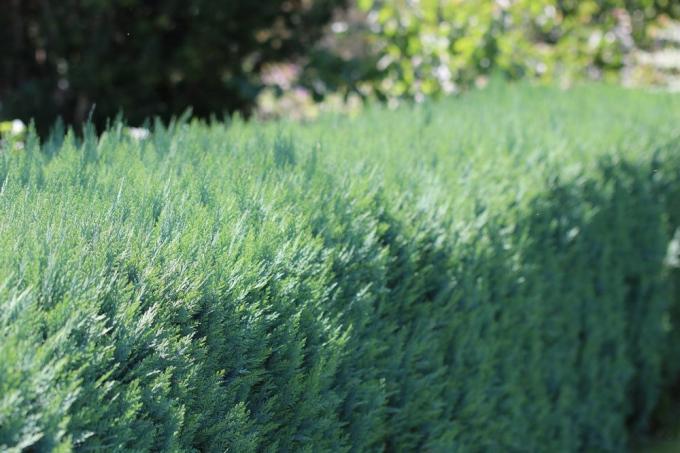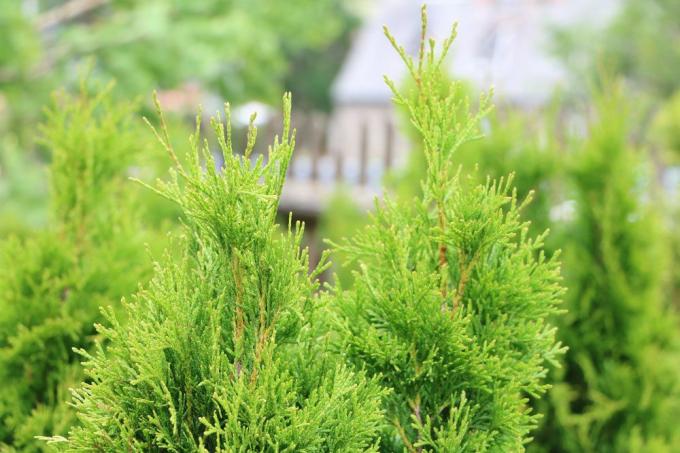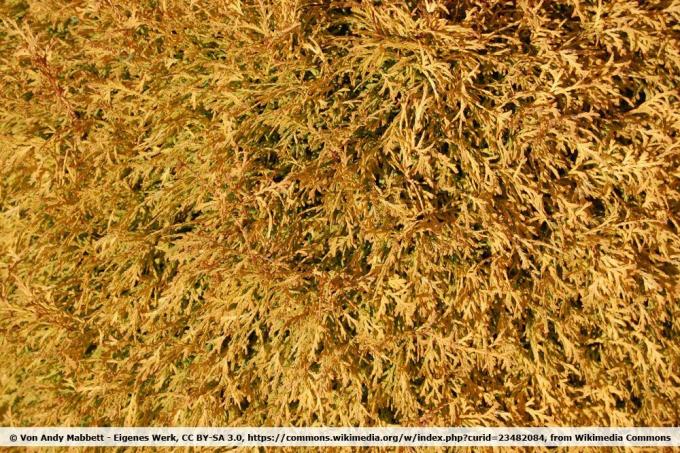
table of contents
- The right kind of thuja
- Thuja for the hedge
- From A - C
- From E - M
- Thujen as a solitaire
- Thuja varieties for pots and small gardens
- From A - G
- From R - W
The larger the market supply, the more difficult it is for us to make a decision. Which thuja is best suited for our project? Most common will be about the varieties Brabant and emerald seized. But new varieties also lure with special properties. The good thing about this wide selection is that it has the right variety for every purpose. We just have to discover it. Let us therefore take a look at the typical characteristics of some selected trees of life.
The right kind of thuja
Thujas are popular woods and have a variety of uses. You too can find the right Thuja variety for hedges or pots.
Thuja for the hedge
When the cold and darkness fall over the country from autumn onwards, thuyens still keep their soft needles. Some varieties even have an enchanting color change. This aspect is particularly welcome in winter, when other hedges with their bare branches are “transparent” and reveal the property to strangers.
Today trees of life are offered in more than 120 varieties. It goes without saying that they differ from one another in a number of ways. All of the thuja varieties presented below have properties that are ideal for the rapid creation of a living hedge. You can decide which variety you want to plant personally based on its appearance and other criteria.
From A - C
Atrovirus
Thuja plicata Atrovirens is a giant arborvitae that grows rapidly in its youth. This hardy variety is therefore a good choice when a high hedge is needed quickly.
- thrives on almost any soil
- the needles shine nicely
- remain deep green even in winter
- they give off a spicy scent
tip: If this thuja is cut twice a year, it grows densely branched and the new shoot gives it a vital and youthful appearance.
Brabant
The Brabant variety belongs to the Thuja occidentalis species. The trees of this kind are also known as occidental arborvitae. They grow tall and are all easy to care for. Brabant is very popular and will therefore not be missing in any tree nursery. This tree of life is ideal when medium-high and high hedges are desired. These are the main features:
- Brabant has horizontal, densely branched branches
- Needles are colored green
- New shoots have a yellowish sheen
- grows about 30 cm per year
- grows to a height of 4 m
- is very easy on cutting and very hardy
- also suitable for dry areas

Columna
Reach for this strain if you live in a rough area. It easily survives -30 degrees Celsius. However, for its summer growth it needs sun, max. Penumbra. You can also use it if you don't like the typical thuja scent. The Columna variety exudes it only very gently, barely noticeable.
- grows columnar
- puts approx. 20 cm in height and width
- becomes a total of up to 4 m high and about 1.5 m wide
- only needs to be cut minimally
tip: Due to the columnar shape, expect 2-3 plants per meter of hedge. Of course, this tree of life can also stand on its own without losing any of its beauty.
From E - M
Excelsa
The Riesenthuja Excelsa is a robust, evergreen and hardy conifer. Your soil requirements are low. Like all thuja, it does not like extreme drought. Its soft leaf is elegant and shiny. It can be pruned back well in the form of a hedge, but does not tolerate heavy pruning into old wood. So that it still grows compactly, it should be cut once or twice every year.

Holmstrup
This variety from Denmark is slow growing. It is useful when you want to create a low hedge.
- stays green throughout
- grows 10-15 cm in height and width per year
- is suitable for framing garden areas
- also shines as a solitaire
tip: Thuja Holmstrup has stable roots that give it good stability. You can safely plant them in a windy garden.

Martin
This giant tree is made for giant hedges. It is also robust and can be used in different living conditions.
- suitable for hedges up to 5 m high
- grows compact and opaque
- its sheet is shiny
Thujen as a solitaire
Some thuja varieties have beautifully colored needles and a naturally pleasing growth habit. You deserve to be admired from all sides. Instead of planting them in a row with other specimens, they should be offered a place in the middle of the garden. The following types of thuja are suitable for this.
Aurescens
Even in a large garden, the tree of life Aurescens with its height of up to 8 m is definitely not overlooked. It is a shame to squeeze this magnificent thuja into a hedge.
- grows into a pointed cone
- is also leafy at the same time
- has decorative yellow tips
- is fast-growing and undemanding
- as well as windproof and hardy
emerald
The tree of life emerald is very popular in this country. Its name also reveals one of the reasons: the color. His needle dress shines green like the gem emerald. Although the Thuja Smaragd can also be raised well as a hedge, a stand-alone position is ideal. It grows so elegantly and uniformly that cutting is hardly necessary.
- grows approx. 20 cm per year
- tolerates sunny and shady places
- does not have great demands on the soil
- is only sensitive to drought

Sunkist
The tree of life Sunkist shines bright gold with the sun in competition. With this and its slim cone shape, it looks extremely attractive as a solitaire.
- grows 20-30 cm annually
- becomes 2-3 m high and 1-2 m wide
- loves plenty of light
- also a permeable, fresh soil

Yellow ribbon
The typical thing about this tree of life is its bright yellow color of leaves. If you want a year-round eye magnet for your garden, you are guaranteed to get one with Yellow Ribbon. In addition to winter hardiness and cut tolerance, the following information is also of interest:
- conical, dense growth
- grows 30 cm per year
- reaches 8 m high and 2.5 m wide
- high location tolerance
- good regenerative ability
Thuja varieties for pots and small gardens
Some tree of life species grow very slowly and remain modestly small overall. They never become a real hedge. But they are ideally suited as long-lasting planting in large containers or as solitaires in a small garden. You can use them to set green accents to the left and right of the entrance door. Or just let them spread their charm on the terrace. Which varieties are well suited for this project? Many. We present a selection to you.
From A - G
Aurea Nana
Aurea Nana is a bushy, conical tree that grows very slowly at 10 to 20 cm per year. At a young age he can optically go under in a large garden. But its golden yellow presence in a bucket is impressive. With a height of 1.5 m, it becomes a giant among the potted plants.
Danica
Which plant grows into a ball on its own without the owner having to use scissors on a regular basis? The dwarf huja Danica is such a tree. Whenever a green ball is welcome as a design element, you can plant Danica.
- can grow up to 80 cm
- from spring to summer the foliage is green
- in autumn the ball turns brown
- from April to May Danica flowers inconspicuously yellow
- then small brown cones form

tip: Cut back Danica slightly in the period from June to July in order to optimize its spherical shape even more.
Golden Globe
At 1 m, the Golden Globe is slightly larger than Danica. The dwarf huja grows into a flat, round shape. The color of the soft needles is green-yellow, their shoot tips are pale orange.
- Branches hang down slightly in the edge area
- Golden Globe loves a place in the sun
- wants a nutrient-rich and well-drained substrate
tip: This dwarf huja doesn't just look good in a pot. It is also a great eye-catcher in a garden covered with small stones. Her beauty is served as if on a presentation plate.
From R - W
Rheingold
Rheingold has different types of growth. This tree of life can thrive as a 4 m high conifer in the garden or as a bonsai in a pot.
- grows slowly at 5 to 15 cm per year
- has delicate branches
- the shoot is yellowish
- rather spherical in youth
- then broadly columnar, with a strong central shoot

Teddy
This tree of life doesn't get any bigger than a big teddy bear. That is why there is a place for this conifer anywhere. You can even plant one, or even better, several teddy bears in the balcony box.
- grows spherical round
- has very fine and dense foliage
- stays green throughout
Tiny Tim
"Tiny Tim" is a dwarf huja and therefore ideally suited for a bucket life. As a hardy plant, you can of course also plant them directly in the garden. In any case, this thuja also thrives in the middle of the city air.
- develops broadly spherical
- is very slow with 3-5 cm growth per year
- the scales are densely arranged
- Foliage color is dark green, brownish in winter
- just needs to be cut lightly
tip: Tiny Tim is also well suited for grave design. The dwarf huja brings green accents to the smallest of spaces and can also stand in close proximity to flowering plants.
Whipcord
Do you only have a very small garden to offer? Whipcord will still find enough space in it. The dwarf huja is only about 0.4 m high. But it offers an amazing crown.
- long, thin branches that curve downwards
- shiny green needles hang down like threads
- grows only about 3 cm per year

tip: The modest space in a bucket is guaranteed to be enough for the small Whipcord. So if you don't have a garden, you don't have to do without this thuja!
